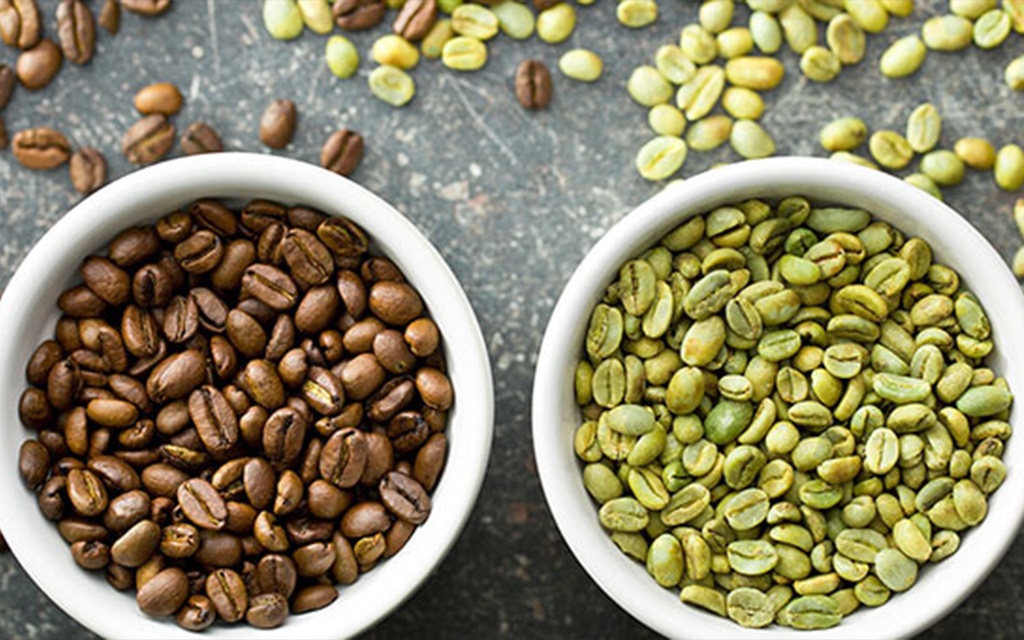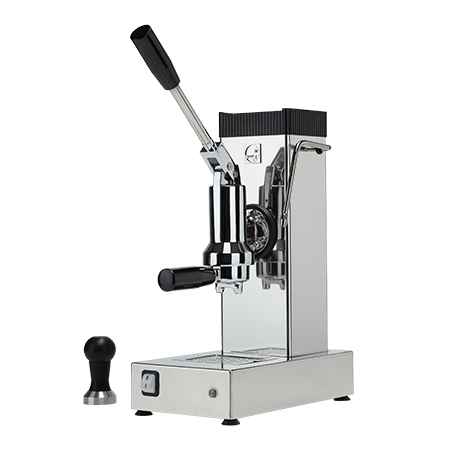A drink with countless qualities, green coffee has a less strong taste than traditional espresso. Its main characteristic is that it is extracted from raw coffee beans, that is, not subjected to the roasting process. Compared to roasted coffee, therefore, it has a lower caffeine content and a more neutral flavour. It is suitable to those who don’t want to give up the pleasure of sipping a coffee but are particularly sensitive to coffee.
Consuming green coffee causes fewer side effects than espresso coffee, and it’s a way to give attention to your body pleasantly. It is commercially available as supplements, in sachets or in grains, and it can be extracted by infusion or with a manual coffee machine.
It’s a light-coloured drink that can be compared to the green tea and has a distinctive herbal taste. Drinking green coffee, however, is not recommended for its flavour but for its beneficial properties. Actually, it is a drink rich in nutritional, anti-cancer and antioxidant properties.
It is often used in slimming diets because it limits the absorption of sugars in the intestine. And this is the reason why it is very popular and boasts a large number of admirers.
Have you ever heard about it? Are you wondering how green coffee is prepared and what it tastes like? Today, we’ll talk about this drink. We’ll tell you how it is prepared and what are the benefits it can give.
What is green coffee
Green coffee is a drink similar to green tea, light-coloured and bright, almost yellow.
Its main characteristic is that the beans are not roasted, therefore they keep their greenish coloured. The only process that green coffee beans are subjected is the exsiccation, that favours the grinding and the extraction of the drink.
Unlike the traditional espresso, it is low in caffeine. The exsiccation, actually, helps keep the amount of chlorogenic acid high, and it reduces the absorption of caffeine in the body.
The chlorogenic acid is an active ingredient with multiple beneficial properties and which does not create tolerability problems. Its action is particularly useful after meals, since it regulates the action of glucose in the blood and helps reduce postprandial blood sugar levels. Having a coffee after a meal, therefore, could speed up metabolism and favour weight-loss.
The unroasted coffee, furthermore, has an antioxidant action and fights free radicals, contributing to cell turnover and tissue regeneration. Many studies shown that green coffee is one of the richest sources of chlorogenic acid and polyphenols, that helps to prevent the spread of bacteria and inflammations.
Why is it called green coffee
Green coffee is nothing more than raw coffee and takes that name from to the colour that the beans have in nature. These beans, in fact, once collected, are simply dried so, they keep the acid green and yellow hue that characterizes them.
The dark colour that has always been associated with coffee beans, is nothing more than the result of the roasting process. The green coffee is of the highest quality because, it keeps its original appearance and, it’s not subjected to any organoleptic alterations, so it does not lose its nutritional properties.
When we say green coffee, we talk about both the coffee beans and the drink that is extracted from them. The plant from which green coffee comes is Coffea, of the Arborea tropicale species. Nowadays, it is possible to find coffee plantations in many countries of the equatorial area, but it seems that it has an Ethiopian origin. The best green coffee quality is Coffea Arabica, it has many pleasant and aromatic features.
The coffee beans are harvested in the same way, for both raw and roasted coffee:
- Once the Coffea fruits have finished their ripening process they are harvested.
- After collecting them, the peel and pulp are removed.
Now, the black coffee is roasted, while the green coffee is spread and dried on rammed earth. The exsiccation process lasts from fifteen to thirty days and can take place both mechanically and naturally.
What is the difference with espresso

As the coffee lover that you undoubtedly are, you will probably find it difficult to replace your morning cup of espresso with a cup of green coffee. Nevertheless, there is no doubt that the latter can provide innumerable benefits, especially to the body of people suffering from hyper-sensitivity to caffeine.
When introduced into their body in the traditional form, i.e. with a normal cup of espresso, caffeine acts much faster, more or less within 30 to 40 minutes. As a result of this accelerated absorption, a series of annoying side effects may then arise, which include:
- hyper – nervous activation;
- insomnia;
- diarrhoea;
- diuresis;
- tachycardia.
Green coffee, on the other hand, ensures much slower absorption, as well as a longer half-life of the caffeine molecules and, consequently, much fewer (if any) side effects. What you must always bear in mind, however, is that what we are describing here are standard reactions, which do not take into account individual factors such as your lifestyle, the doses of caffeine you are used to taking during the day, your tolerance level to the substance, etc.
That’s why, as much as we know about coffee, we first advise you to take this information with a grain of salt and not make too much fuss about when to drink green coffee. In other words: if you are curious to taste it, there is nothing to stop you from doing so.
Since in its pure form it tastes very bitter, however, our advice is to create blends, adding other sweeter and more aromatic ingredients. Mint, ginger, cinnamon, ginseng and cardamom go perfectly well with green coffee, giving it a more enveloping flavour and dampening its bitterness.
Flavoured green coffee is also excellent when consumed cold, but in order not to lose its beneficial effect, it is advisable to avoid sugar.
Beneficial effects of green coffee
Thanks to the chlorogenic acid it contains, green coffee is able to provide numerous beneficial effects, namely:
- lowering of blood pressure values;
- reduction of sugar absorption in the intestines, thus preventing too much sugar from accumulating in the blood;
- regulation of metabolism;
- high antioxidant, anti-inflammatory and antibacterial power.
The credit for these positive aspects can be attributed to the nutritional properties of this drink. In fact, it contains:
- B6 vitamin
- Thiamine
- riboflavin
- niacin
- folate
- calcium
- magnesium
- phosphorus
- potassium
- zinc
Keep in mind, however, that studies on green coffee are still ongoing. This means that there is still a lot to be discovered with regard to its benefits, and this also applies to its effects on body weight loss.
Is it true that green coffee makes you slim?

Green coffee is often indicated as a supplement in slimming diets, either in the form of a drink or in tablet form. The caffeine contained in coffee, both roasted and raw coffee, acts effectively on fat tissue, promoting its elimination.
Unlike traditional coffee, however, green coffee releases caffeine more gradually. Consequently, its activity is prolonged over time and its effects on the body are also longer lasting. By remaining in the bloodstream for longer, caffeine stimulates the metabolism over a longer period of time, with noticeable effects on weight loss.
This molecule promotes weight loss in two ways:
- increases the production of adrenalin and noradrenalin, which can speed up the breakdown of fats in the blood;
- inhibits the absorption of sugar and fat in the intestines.
The lower absorption of sugars is essential in preventing a rapid rise in blood sugar levels and, consequently, in preventing diabetes. Above all, by preventing glycaemic peaks, the metabolism of sugars and fats is activated correctly, preventing the accumulation of fat on the belly. Poor sugar metabolism, in fact, is one of the most important causes of body weight gain.
The fat-burning properties of green coffee also depend on the presence of polyphenols, which prevent the formation of triglycerides and cholesterol in the liver, thus preventing fat accumulation.
Of course, its action alone is not enough to reduce body weight. Real and noticeable results can only be achieved if the consumption of raw coffee is combined with a controlled diet and physical exercise.
Conclusion: discover how to enjoy a nice cup of green coffee
To prepare green coffee, you have two ways. You can in fact obtain it:
- by infusion;
- with a classic coffee machine.
Preparation by infusion is very simple: just put the sachet in hot water for about 10 to 15 minutes and wait until the drink is ready. The main caution is to pay attention to the temperature of the water. Unlike other infusions or drinks containing theine or caffeine, raw coffee is thermolabile so the water must not exceed 80°, otherwise the nutritional properties of the substance will be lost.
To enjoy your green coffee without giving up the espresso ritual, you can choose raw coffee beans and use a professional coffee machine to prepare the drink. Again, the process does not require much effort.
One buys the beans, usually available in herbalist shops or roasting shops, and grinds them with a mortar or kitchen mixer. The coffee machine is switched on so that it reaches the indicated water temperature. Then the filter is filled and the extraction is performed.
The most aromatic raw coffee variety suitable for preparation with a coffee machine is Coffea Arabica. With an intense and pleasant aroma, this variety is extremely valuable and has an optimal consistency for pulverising.
Preparing green coffee with a professional coffee machine is the best way to preserve its nutritional properties. Moreover, with the Pontevecchio lever coffee machine, you can rediscover gestures and adjust the machine’s parameters perfectly to extract a rich and healthy green coffee.
This is because if you want to drink good coffee, you should do it with the right machine: a discourse that applies just as much to espresso as to green coffee. So don’t wait any longer: consult our catalogue now and discover the right coffee machine for you!








